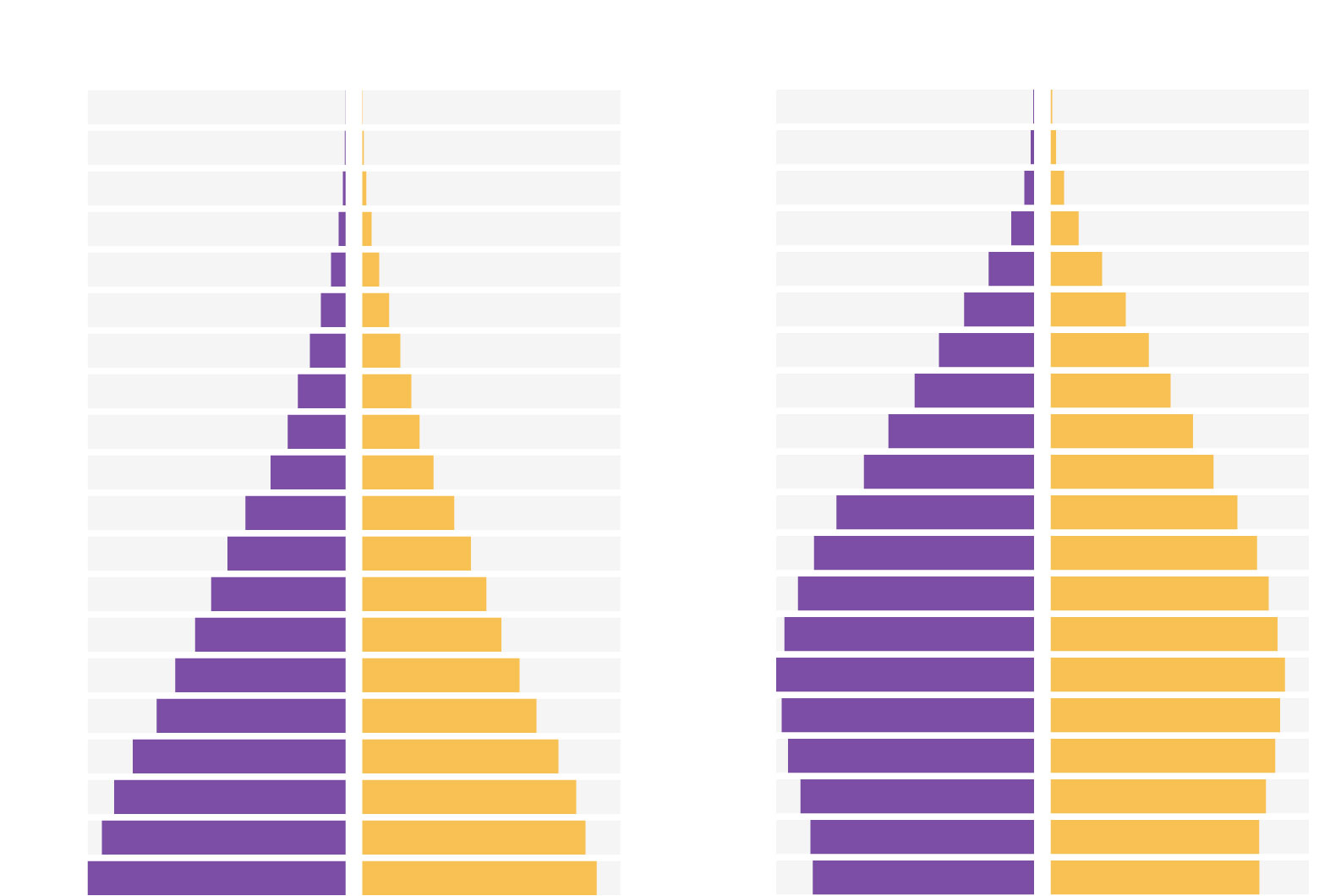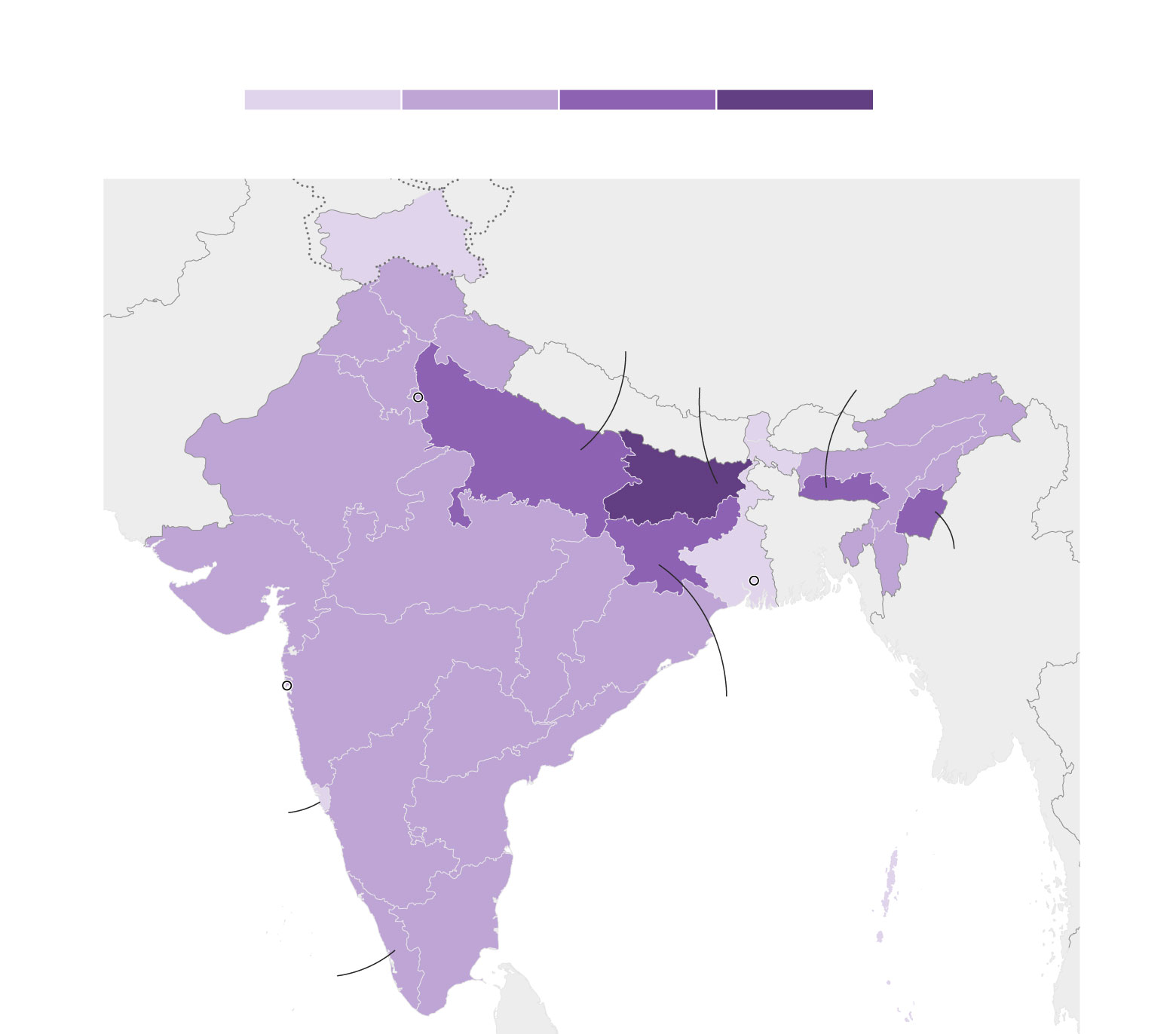News
India Surpassed China In Population: What Lies Ahead For India?

(CTN News) – Counting millions of people is never an easy chore, but according to the United Nations’ most recent estimations.
India will surpass China in population by the end of this weekend, signaling a historic shift in the world’s demographics.
The majority of the globe grew up believing that China was the most populated nation, yet decades of stringent laws requiring just one child per family drastically reduced China’s birthrate, giving India the advantage.
However, the majority of nations do not necessarily aspire to have a chart-topping headcount.
A few years ago, Prime Minister Narendra Modi expressed concern about India’s “population explosion” and praised families for carefully weighing the effects of having more children – both on themselves and the country.
“In India in the twenty-first century, the capacity to realise dreams begins with a person, begins with a family. “Neither the home nor the nation can be happy if the populace is not educated and healthy,” Modi stated.
What caused India’s population to grow so quickly, and how long will it continue?
CNN examined statistics from the UN’s World Population Prospects and consulted with specialists to go behind the headline figures and examine the specifics of India’s demographic change.

Why Did India Become So Big?
Fertility is crucial to understanding what causes a country’s population to increase or decrease, which is not surprising.
It is generally acknowledged that for a nation’s population to maintain itself and even increase, the average fertility rate, or the number of children per woman, must be 2.1.
India’s fertility rate in the 1960s, when the grandparents of today’s generation were having children, was 6, or about the same as certain African nations presently.
The total fertility rate in India, however, decreased to 2.0 in the most recent national evaluation period from 2019 to 2021, down from 3.4 in 1992–1993.
The concept of “demographic momentum” helps to explain why the population is growing despite a decline in birth rates.
“The population grows for several decades after the fertility rate falls. Frank Swiaczny, a senior researcher at the Federal Institute for Population Research, explained that this is the case because younger, larger cohorts are still maturing into the age when they become parents.
Due to the significant number of women entering their reproductive years, India’s population will thus continue to expand slowly even with a replacement or sub-replacement fertility rate.
India’s unequal fertility rate across the country contributes to a north-south divide where more children are born in the north, which is not unusual for a country of its size. However, even there, the figures aren’t astronomically high.
“What really surprised us is that the highest fertility rate in India — 3.0 in Bihar — is not even that high,” said Barbara Seligman.
Chief strategy and growth officer and senior vice president at PRB, a nonprofit organisation that focuses on demographic information and population studies.

“It is really striking to see just how many states are below replacement level,” Seligman continued. Except for five states, all of which are in the north (Bihar, Meghalaya, Uttar Pradesh, Jharkhand, and Manipur), are at that level.
A separate pattern appears in the southern states.
For instance, Goa’s fertility rate is comparable to that of some southern European nations that are currently having trouble keeping up with an ageing population and a declining labour force.
Experts advise India’s leaders not to disregard this trend.
India is now considered to be a “ageing society” by the UN, which means that 7% of its citizens are 65 years of age or older. In other regions, like Kerala in southern India, where 12% of the population is over 65, that number has doubled in the past 30 years.
Given the low overall fertility rate, the same pattern will spread to more states.
Over the course of the next 30 years, “we’re going to see more and more states ageing in the way that Kerala is now,” Seligman predicted.
India’s Population Is Growing Less Quickly
India’s population may have surpassed China’s overall, but according to UN figures, the country’s growth pace has halted.
India’s population grew by 2.2% year on average between 1971 and 1981. That had slowed to 1.5% by 2001 to 2011, and it is even lower now. India’s population is anticipated to reach its peak in 2064 at roughly 1.7 billion, according to UN estimates.
According to UN figures, the country’s predicted median age in 2023 would be 28 — over a decade younger than China’s. Currently, more than 40% of the population is under 25.
According to the Organisation for Economic Cooperation and Development (OECD), India has more than 900 million people of working age in 2021, and that number is projected to rise to 1 billion over the following ten years.
The country is a huge lure for Western businesses looking for an alternative manufacturing base to China because of its large, young, English-speaking, digitally educated, and reputation for entrepreneurship labour force as well as its low wages.
However, it is anticipated that India will contribute less to the proportion of the world’s working-age population in the coming decades, making room for a younger generation of workers who will be leaving Africa.

Although India may have the majority of people in working age today, experts say the country needs strong policies to take advantage of its youth.
According to Sonalde Desai, director at the National Council of Applied Economic Research (NCAER) and professor at the University of Maryland, “a large number of people is not enough; we need to develop a comprehensive plan.”
“We need an economy that creates these high-value jobs as well as people with the skills to fill some of the high-value jobs.”
The Population Foundation of India’s executive director, Poonam Muttreja, stated that closing the gap is “imperative for India to progress to fulfil its aspirations of being a developed country.”
What Lies Ahead For India?
India is climbing the global economic league tables while still having one of the lowest per capita incomes in the world; its approximately $3.5 trillion economy is now the fifth largest and one of the fastest growing in the world.
The World Bank predicts that India will outperform all other major economies in 2023 with growth of 6.6%, compared to China’s 4.3% and the United States’ 0.5%.
According to some projections, India is also predicted to overtake China as the world’s third largest economy within the next 10 years and be the only third country to reach a GDP of $10 trillion by 2035.

India Has Prospered, But Its Wealth Is Not Distributed Equally
Millions of Indians continue to live in poverty, and analysts claim that despite the country having a sizable population of young people who are ready and prepared to work, compared to other nations, statistics reveal that there aren’t enough jobs for them.
The issue is greater in economically underdeveloped northern regions that mainly rely on agriculture. For instance, Uttar Pradesh, which is home to 17% of India’s population, only possesses 9% of the nation’s industrial jobs.
Although India may have the majority of people in working age today, experts say the country needs strong policies to take advantage of its youth.
According to Sonalde Desai, director at the National Council of Applied Economic Research (NCAER) and professor at the University of Maryland, “a large number of people is not enough; we need to develop a comprehensive plan.”
“We need an economy that creates these high-value jobs as well as people with the skills to fill some of the high-value jobs.”
The Population Foundation of India’s executive director, Poonam Muttreja, stated that closing the gap is “imperative for India to progress to fulfil its aspirations of being a developed country.”

News
Trudeau’s Gun Grab Could Cost Taxpayers a Whopping $7 Billion

A recent report indicates that since Trudeau’s announcement of his gun buyback program four years ago, almost none of the banned firearms have been surrendered.
The federal government plans to purchase 2,063 firearm models from retailers following the enactment of Bill C-21, which amends various Acts and introduces certain consequential changes related to firearms. It was granted royal assent on December 15 of last year.
This ban immediately criminalized the actions of federally-licensed firearms owners regarding the purchase, sale, transportation, importation, exportation, or use of hundreds of thousands of rifles and shotguns that were previously legal.
The gun ban focused on what it termed ‘assault-style weapons,’ which are, in reality, traditional semi-automatic rifles and shotguns that have enjoyed popularity among hunters and sport shooters for over a century.
In May 2020, the federal government enacted an Order-in-Council that prohibited 1,500 types of “assault-style” firearms and outlined specific components of the newly banned firearms. Property owners must adhere to the law by October 2023.
Trudeau’s Buyback Hasn’t Happened
“In the announcement regarding the ban, the prime minister stated that the government would seize the prohibited firearms, assuring that their lawful owners would be ‘grandfathered’ or compensated fairly.” “That hasn’t happened,” criminologist Gary Mauser told Rebel News.
Mauser projected expenses ranging from $2.6 billion to $6.7 billion. The figure reflects the compensation costs amounting to $756 million, as outlined by the Parliamentary Budget Office (PBO).
“The projected expenses for gathering the illegal firearms are estimated to range from $1.6 billion to $7 billion.” “This range estimate increases to between $2.647 billion and $7 billion when compensation costs to owners are factored in,” Mauser stated.
Figures requested by Conservative MP Shannon Stubbs concerning firearms prohibited due to the May 1, 2020 Order In Council reveal that $72 million has been allocated to the firearm “buyback” program, yet not a single firearm has been confiscated to date.
In a recent revelation, Public Safety Canada disclosed that the federal government allocated a staggering $41,094,556, as prompted by an order paper question from Conservative Senator Don Plett last September, yet yielded no tangible outcomes.
An internal memo from late 2019 revealed that the Liberals projected their politically motivated harassment would incur a cost of $1.8 billion.
Enforcement efforts Questioned
By December 2023, estimates from TheGunBlog.ca indicate that the Liberals and RCMP had incurred or were responsible for approximately $30 million in personnel expenses related to the enforcement efforts. The union representing the police service previously stated that the effort to confiscate firearms is a “misdirected effort” aimed at ensuring public safety.
“This action diverts crucial personnel, resources, and funding from tackling the more pressing and escalating issue of criminal use of illegal firearms,” stated the National Police Federation (NPF).
The Canadian Sporting Arms & Ammunition Association (CSAAA), representing firearms retailers, has stated it will have “zero involvement” in the confiscation of these firearms. Even Canada Post held back from providing assistance due to safety concerns.
The consultant previously assessed that retailers are sitting on almost $1 billion worth of inventory that cannot be sold or returned to suppliers because of the Order-In-Council.
“Despite the ongoing confusion surrounding the ban, after four years, we ought to be able to address one crucial question.” Has the prohibition enhanced safety for Canadians? Mauser asks.
Illegally Obtained Firearms are the Problem
Statistics Canada reports a 10% increase in firearm-related violent crime between 2020 and 2022, rising from 12,614 incidents to 13,937 incidents. In that timeframe, the incidence of firearm-related violent crime increased from 33.7 incidents per 100,000 population in 2021 to 36.7 incidents the subsequent year.
“This marks the highest rate documented since the collection of comparable data began in 2009,” the criminologist explains.
Supplementary DataData indicates that firearm homicides have risen since 2020. “The issue lies not with lawfully-held firearms,” Mauser stated.
Firearms that have been banned under the Order-in-Council continue to be securely stored in the safes of their lawful owners. The individuals underwent a thorough vetting process by the RCMP and are subject to nightly monitoring to ensure there are no infractions that could pose a risk to public safety.
“The firearms involved in homicides were seldom legally owned weapons wielded by their rightful owners,” Mauser continues. The number of offenses linked to organized crime has surged from 4,810 in 2016 to a staggering 13,056 in 2020.
“If those in power … aim to diminish crime and enhance public safety, they ought to implement strategies that effectively focus on offenders and utilize our limited tax resources judiciously to reach these objectives,” he stated.
Related News:
Millennials in Canada Have Turned their Backs on Justin Trudeau
Millennials in Canada Have Turned their Backs on Justin Trudeau
News
Google’s Search Dominance Is Unwinding, But Still Accounting 48% Search Revenue

Google is so closely associated with its key product that its name is a verb that signifies “search.” However, Google’s dominance in that sector is dwindling.
According to eMarketer, Google will lose control of the US search industry for the first time in decades next year.
Google will remain the dominant search player, accounting for 48% of American search advertising revenue. And, remarkably, Google is still increasing its sales in the field, despite being the dominating player in search since the early days of the George W. Bush administration. However, Amazon is growing at a quicker rate.
Google’s Search Dominance Is Unwinding
Amazon will hold over a quarter of US search ad dollars next year, rising to 27% by 2026, while Google will fall even more, according to eMarketer.
The Wall Street Journal was first to report on the forecast.
Lest you think you’ll have to switch to Bing or Yahoo, this isn’t the end of Google or anything really near.
Google is the fourth-most valued public firm in the world. Its market worth is $2.1 trillion, trailing just Apple, Microsoft, and the AI chip darling Nvidia. It also maintains its dominance in other industries, such as display advertisements, where it dominates alongside Facebook’s parent firm Meta, and video ads on YouTube.
To put those “other” firms in context, each is worth more than Delta Air Lines’ total market value. So, yeah, Google is not going anywhere.
Nonetheless, Google faces numerous dangers to its operations, particularly from antitrust regulators.
On Monday, a federal judge in San Francisco ruled that Google must open up its Google Play Store to competitors, dealing a significant blow to the firm in its long-running battle with Fortnite creator Epic Games. Google announced that it would appeal the verdict.
In August, a federal judge ruled that Google has an illegal monopoly on search. That verdict could lead to the dissolution of the company’s search operation. Another antitrust lawsuit filed last month accuses Google of abusing its dominance in the online advertising business.
Meanwhile, European regulators have compelled Google to follow tough new standards, which have resulted in multiple $1 billion-plus fines.

Pixa Bay
Google’s Search Dominance Is Unwinding
On top of that, the marketplace is becoming more difficult on its own.
TikTok, the fastest-growing social network, is expanding into the search market. And Amazon has accomplished something few other digital titans have done to date: it has established a habit.
When you want to buy anything, you usually go to Amazon, not Google. Amazon then buys adverts to push companies’ products to the top of your search results, increasing sales and earning Amazon a greater portion of the revenue. According to eMarketer, it is expected to generate $27.8 billion in search revenue in the United States next year, trailing only Google’s $62.9 billion total.
And then there’s AI, the technology that (supposedly) will change everything.
Why search in stilted language for “kendall jenner why bad bunny breakup” or “police moving violation driver rights no stop sign” when you can just ask OpenAI’s ChatGPT, “What’s going on with Kendall Jenner and Bad Bunny?” in “I need help fighting a moving violation involving a stop sign that wasn’t visible.” Google is working on exactly this technology with its Gemini product, but its success is far from guaranteed, especially with Apple collaborating with OpenAI and other businesses rapidly joining the market.
A Google spokeswoman referred to a blog post from last week in which the company unveiled ads in its AI overviews (the AI-generated text that appears at the top of search results). It’s Google’s way of expressing its ability to profit on a changing marketplace while retaining its business, even as its consumers steadily transition to ask-and-answer AI and away from search.

Google has long used a single catchphrase to defend itself against opponents who claim it is a monopoly abusing its power: competition is only a click away. Until recently, that seemed comically obtuse. Really? We are going to switch to Bing? Or Duck Duck Go? Give me a break.
But today, it feels more like reality.
Google is in no danger of disappearing. However, every highly dominating company faces some type of reckoning over time. GE, a Dow mainstay for more than a century, was broken up last year and is now a shell of its previous dominance. Sears declared bankruptcy in 2022 and is virtually out of business. US Steel, long the foundation of American manufacturing, is attempting to sell itself to a Japanese corporation.
SOURCE | CNN
News
The Supreme Court Turns Down Biden’s Government Appeal in a Texas Emergency Abortion Matter.

(VOR News) – A ruling that prohibits emergency abortions that contravene the Supreme Court law in the state of Texas, which has one of the most stringent abortion restrictions in the country, has been upheld by the Supreme Court of the United States. The United States Supreme Court upheld this decision.
The justices did not provide any specifics regarding the underlying reasons for their decision to uphold an order from a lower court that declared hospitals cannot be legally obligated to administer abortions if doing so would violate the law in the state of Texas.
Institutions are not required to perform abortions, as stipulated in the decree. The common populace did not investigate any opposing viewpoints. The decision was made just weeks before a presidential election that brought abortion to the forefront of the political agenda.
This decision follows the 2022 Supreme Court ruling that ended abortion nationwide.
In response to a request from the administration of Vice President Joe Biden to overturn the lower court’s decision, the justices expressed their disapproval.
The government contends that hospitals are obligated to perform abortions in compliance with federal legislation when the health or life of an expectant patient is in an exceedingly precarious condition.
This is the case in regions where the procedure is prohibited. The difficulty hospitals in Texas and other states are experiencing in determining whether or not routine care could be in violation of stringent state laws that prohibit abortion has resulted in an increase in the number of complaints concerning pregnant women who are experiencing medical distress being turned away from emergency rooms.
The administration cited the Supreme Court’s ruling in a case that bore a striking resemblance to the one that was presented to it in Idaho at the beginning of the year. The justices took a limited decision in that case to allow the continuation of emergency abortions without interruption while a lawsuit was still being heard.
In contrast, Texas has been a vocal proponent of the injunction’s continued enforcement. Texas has argued that its circumstances are distinct from those of Idaho, as the state does have an exemption for situations that pose a significant hazard to the health of an expectant patient.
According to the state, the discrepancy is the result of this exemption. The state of Idaho had a provision that safeguarded a woman’s life when the issue was first broached; however, it did not include protection for her health.
Certified medical practitioners are not obligated to wait until a woman’s life is in imminent peril before they are legally permitted to perform an abortion, as determined by the state supreme court.
The state of Texas highlighted this to the Supreme Court.
Nevertheless, medical professionals have criticized the Texas statute as being perilously ambiguous, and a medical board has declined to provide a list of all the disorders that are eligible for an exception. Furthermore, the statute has been criticized for its hazardous ambiguity.
For an extended period, termination of pregnancies has been a standard procedure in medical treatment for individuals who have been experiencing significant issues. It is implemented in this manner to prevent catastrophic outcomes, such as sepsis, organ failure, and other severe scenarios.
Nevertheless, medical professionals and hospitals in Texas and other states with strict abortion laws have noted that it is uncertain whether or not these terminations could be in violation of abortion prohibitions that include the possibility of a prison sentence. This is the case in regions where abortion prohibitions are exceedingly restrictive.
Following the Supreme Court’s decision to overturn Roe v. Wade, which resulted in restrictions on the rights of women to have abortions in several Republican-ruled states, the Texas case was revisited in 2022.
As per the orders that were disclosed by the administration of Vice President Joe Biden, hospitals are still required to provide abortions in cases that are classified as dire emergency.
As stipulated in a piece of health care legislation, the majority of hospitals are obligated to provide medical assistance to patients who are experiencing medical distress. This is in accordance with the law.
The state of Texas maintained that hospitals should not be obligated to provide abortions throughout the litigation, as doing so would violate the state’s constitutional prohibition on abortions. In its January judgment, the 5th United States Circuit Court of Appeals concurred with the state and acknowledged that the administration had exceeded its authority.
SOURCE: AP
SEE ALSO:
Could Last-Minute Surprises Derail Kamala Harris’ Campaign? “Nostradamus” Explains the US Poll.
-

 News3 years ago
News3 years agoLet’s Know About Ultra High Net Worth Individual
-
Entertainment2 years ago
Mabelle Prior: The Voice of Hope, Resilience, and Diversity Inspiring Generations
-

 Health3 years ago
Health3 years agoHow Much Ivermectin Should You Take?
-

 Tech2 years ago
Tech2 years agoTop Forex Brokers of 2023: Reviews and Analysis for Successful Trading
-

 Lifestyles3 years ago
Lifestyles3 years agoAries Soulmate Signs
-

 Movies2 years ago
Movies2 years agoWhat Should I Do If Disney Plus Keeps Logging Me Out of TV?
-

 Health3 years ago
Health3 years agoCan I Buy Ivermectin Without A Prescription in the USA?
-

 Learning2 years ago
Learning2 years agoVirtual Numbers: What Are They For?
